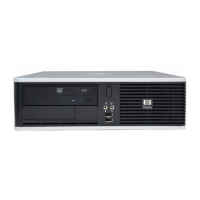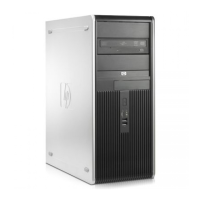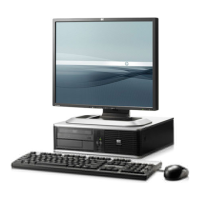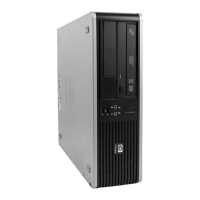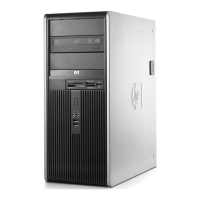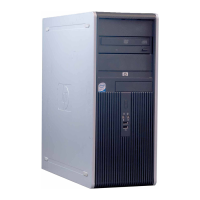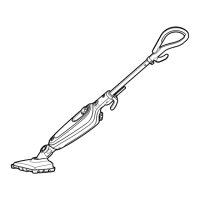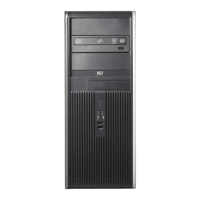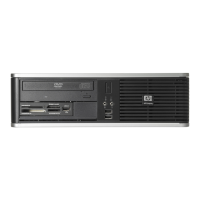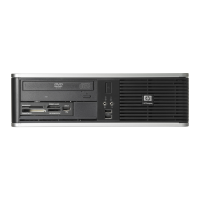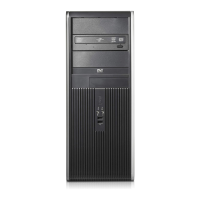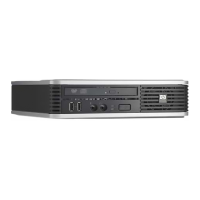
Do you have a question about the HP dc7900 series and is the answer not in the manual?
| Chipset | Intel Q45 Express |
|---|---|
| Memory | Up to 16 GB DDR2 SDRAM |
| Network | Integrated Intel 82567LM Gigabit Network Connection |
| Audio | Integrated High Definition Audio |
| Processor Options | Intel Core 2 Duo |
| Storage Options | Solid State Drive |
| Graphics | Integrated Intel Graphics Media Accelerator 4500 |
| Optical Drive | DVD-ROM |
| Ports | USB 2.0, VGA, DisplayPort, serial, parallel, PS/2, audio in/out |
| Form Factor | Small Form Factor (SFF) |
| Operating System | Windows XP |
| Power Supply | 240W |
| Expansion Slots | PCI Express x16 |
Details the standard configuration components and features of the HP Compaq Ultra-Slim Desktop computer.
Identifies and describes the components located on the front panel of the computer.
Identifies and describes the connectors and components located on the rear panel of the computer.
Details the layout and function of the keys on the HP computer keyboard.
Explains the functions and shortcuts available using the Windows Logo key in the operating system.
Indicates the location of the serial number and product ID on the computer for customer service.
Highlights features that facilitate easy upgrading and servicing of the computer without tools.
Provides essential safety instructions and warnings to follow before performing hardware upgrades.
Step-by-step instructions for properly connecting the power cord to the computer and outlet.
Details the procedure for removing the computer's access panel to access internal components.
Instructions on how to properly reinstall the computer's access panel after performing maintenance.
Guides the user through the process of removing and reinstalling the front bezel of the computer.
Explains how to remove a bezel blank from the drive bay before installing a drive.
Provides steps to convert the computer's physical configuration from desktop to tower orientation.
Instructions for installing DDR2-SDRAM SODIMMs, including specifications and requirements.
Details the location and population rules for SODIMM sockets on the system board for dual channel operation.
Step-by-step guide for safely installing SODIMM memory modules into the computer's sockets.
Instructions for removing the existing optical drive and installing a new one.
Guides on attaching the release latch to a new optical drive before installation.
Step-by-step instructions for installing the prepared optical drive into the computer bay.
Detailed procedure for backing up data and replacing the 2.5-inch SATA hard drive.
Instructions for installing and removing the optional rear port cover for security.
Provides the physical dimensions (height, width, depth) of the computer in desktop configuration.
States the approximate weight of the computer in pounds and kilograms.
Specifies the acceptable operating and non-operating temperature ranges for the computer.
Details the acceptable relative humidity levels for operating and non-operating conditions.
Specifies the maximum altitude at which the computer can operate and be stored.
Provides information on the heat output of the computer in BTU/hr and kg-cal/hr.
Details the operating voltage range, rated voltage range, line frequency, and power output.
Specifies the maximum input current requirements for the computer's power supply at different voltages.
Procedure for replacing a coin cell battery in a Type 1 battery holder.
Procedure for replacing a coin cell battery in a Type 2 battery holder.
Procedure for replacing a coin cell battery in a Type 3 battery holder.
Provides instructions for installing cable locks and padlocks to secure the computer.
Explains how to use cable locks with and without a port cover installed.
Illustrates how to use a padlock to secure the computer.
Details how to attach and engage the HP Business PC security lock to the chassis.
Lists precautions to take to avoid electrostatic damage when handling computer parts.
Describes various methods for proper grounding to prevent static discharge during handling.
Offers recommendations for proper setup, operation, and maintenance of the computer.
Guidelines for operating and cleaning the computer's optical drive safely.
Provides essential steps and considerations for safely preparing the computer for shipment.
